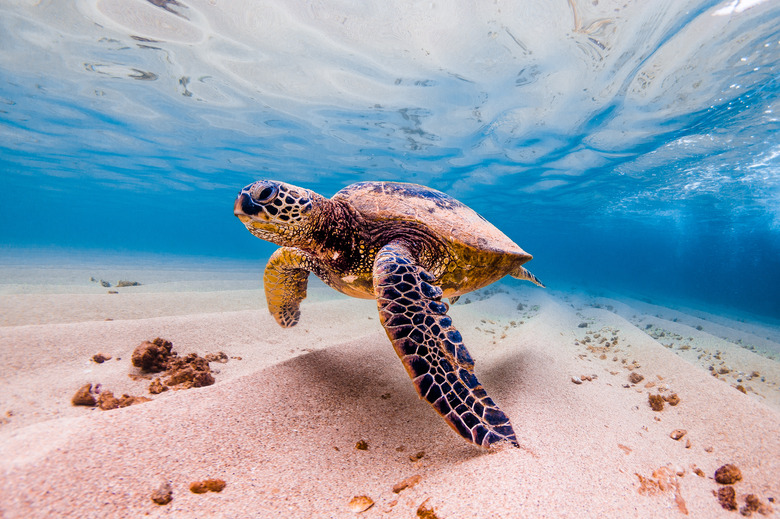What Are The Adaptations For Survival For Seagrass?
Seagrasses are submerged flowering plants that live in shallow coastal waters. They play a vital role in preserving the biodiversity of sea life, as they shelter or nourish thousands of animal or plant species, and help to keep the oceans healthy by locking away carbon and releasing oxygen. Adapted to life in salt water by evolution from land-based plants, seagrass is constantly adapting to natural changes in the environment caused by weather and rising sea levels. However, it may not be able to adapt to the severe and increasing damage now being caused by human activity. It may recover only if people recognize its importance, restore what they have ruined and stop causing further destruction.
Adaptation to the Marine Environment
Seagrasses have evolved to withstand various degrees of salinity. They can also tolerate temperatures ranging from minus 6 to 40 degrees C. Their horizontal stems, called rhizomes, enable them to cope with the tugging of currents and waves. Roots grow down from the rhizome to anchor the plant to the seabed, while flexible blades grow straight up and can bend to the current without resistance. In mixed seagrass colonies, short-leaved, fast-growing grasses form a mat that traps sediment and stabilizes the seabed, allowing taller, slower-growing varieties to establish roots.
Natural Threats to Survival
Climate change due to global warming threatens both marine and terrestrial ecosystems. Storms, earthquakes and tsunamis can rip up seagrass fields and fill the water with mud and debris. However, living mats of seagrass usually help protect the shoreline by diffusing the violence of waves, and seagrass does grow back eventually. Seagrass responds to rising sea levels by spreading shore-wards into shallower water. The sediment it collects helps prevent erosion and slow the rate at which land area is lost to the sea.
Man-made Threats
As well as fueling global warming, human activities directly endanger seagrass in ways that are difficult for it to adapt to. Sewage, oil spills and agricultural and industrial waste pollute the water and make it murky. Seagrass needs clear, sunlit water for photosynthesis. Without it, the plants die and rot, resulting in more, not less, greenhouse gases, as well as loss of habitat for the other plants and animals that depended on the grass. Coastal development that involves dredging harbors and building sea-walls and jetties can destroy seagrass meadows and disrupt currents. Boat propellers can also tear up seagrass, leaving deep scars.
Importance to the Survival of Other Species
Seagrass helps mitigate the effects of global warming in several ways. It acts as a carbon sink by absorbing carbon dioxide, while producing oxygen through photosynthesis. It stabilizes the seabed, protecting coastlines from erosion and storm damage. It filters sediment and calms waves.
Seagrass meadows provide food and shelter for seahorses, turtles, coral reefs, marine mammals like dugongs and manatees, and thousands of fish species. By acting as a marine nursery, the meadows support recreational and commercial fishing as well as ecotourism. Protecting and promoting the growth of seagrass, therefore, represents a way for coastal communities — human, plant and animal — to cope with some of the effects of climate change.
Helping Seagrass Survive
People must realize that seagrass is as important to marine ecosystems as coral reefs and salt marshes, and as critical to the world's oxygen/carbon dioxide balance as the rain forests. The key to restoring or maintaining seagrass meadows is enlightened management at state, federal and local level. This involves mapping, monitoring and analysis so that programs of education and conservation can be planned in the most effective way. Replanting can help, but must be supported by improvements in water quality and regulation of activities like boating and building, so that the seagrass has a chance to thrive.
Cite This Article
MLA
Brown, Judy. "What Are The Adaptations For Survival For Seagrass?" sciencing.com, https://www.sciencing.com/adaptations-survival-seagrass-8547892/. 13 March 2018.
APA
Brown, Judy. (2018, March 13). What Are The Adaptations For Survival For Seagrass?. sciencing.com. Retrieved from https://www.sciencing.com/adaptations-survival-seagrass-8547892/
Chicago
Brown, Judy. What Are The Adaptations For Survival For Seagrass? last modified March 24, 2022. https://www.sciencing.com/adaptations-survival-seagrass-8547892/
